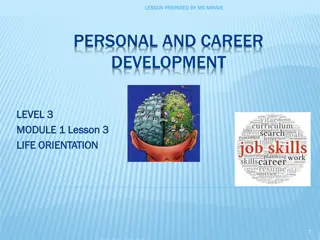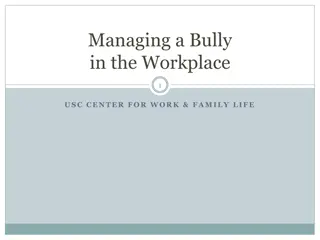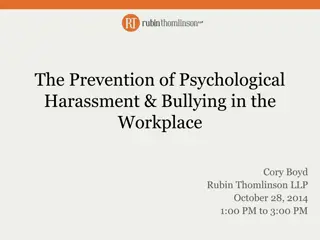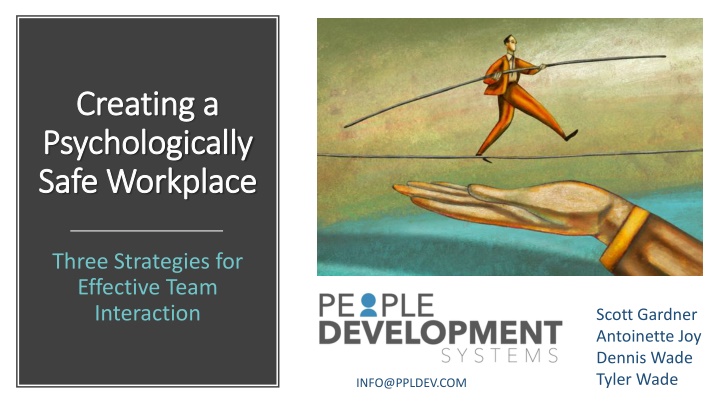
Effective Strategies for Building Psychological Safety in the Workplace
Learn about the importance of psychological safety in teams and how to recognize its absence. Explore three key strategies for fostering psychological safety, including engagement, inclusivity, and gratitude. Build a supportive environment where team members feel comfortable taking risks and sharing ideas.
Download Presentation

Please find below an Image/Link to download the presentation.
The content on the website is provided AS IS for your information and personal use only. It may not be sold, licensed, or shared on other websites without obtaining consent from the author. If you encounter any issues during the download, it is possible that the publisher has removed the file from their server.
You are allowed to download the files provided on this website for personal or commercial use, subject to the condition that they are used lawfully. All files are the property of their respective owners.
The content on the website is provided AS IS for your information and personal use only. It may not be sold, licensed, or shared on other websites without obtaining consent from the author.
E N D
Presentation Transcript
Creating a Creating a Psychologically Psychologically Safe Workplace Safe Workplace Three Strategies for Effective Team Interaction Scott Gardner Antoinette Joy Dennis Wade Tyler Wade INFO@PPLDEV.COM
Objectives Objectives By the end of this presentation, you will know: What psychological safety is and why it matters The symptoms for recognizing when your team lacks psychological safety Strategies for building psychological safety on your team A specific tool and technique for building psychological safety on your team 2
What is Psychological Safety (PS)? What is Psychological Safety (PS)? A belief: the team is a safe place for taking risks Team members won t embarrass or punish each other for: Making a mistake Asking a question Offering a new idea It doesn t mean your ideas won t be challenged or you won t like the answer It means you get the best from team members 3
Dynamics of Effective Teams 4
Symptoms of a team lacking PS Symptoms of a team lacking PS Team members will: Conceal their weaknesses and mistakes from others Hesitate to ask for help or provide constructive feedback Waste time and energy managing their behaviors for effect Hold grudges Dread meetings and find reasons to avoid spending time together Have boring or irrelevant meetings Ignore controversial topics that are crucial to team success Have a meeting outside of the meeting 7
Three strategies for building PS Three strategies for building PS Demonstrate engagement Be present put away your laptop and smartphone Offer input Check body language and facial expressions Show understanding Validate comments Ask questions for understanding Focus on the situation or issue, not the person Be inclusive Express gratitude Be approachable Solicit input, opinions, and feedback from teammates Don t interrupt Respect the agreed-upon decision-making method 8
A tool for building PS: A Team Operating A tool for building PS: A Team Operating Agreement (TOA) Agreement (TOA) A team operating agreement what is it? Why have a team operating agreement? How to create one Exercise Individually, read through the operating agreement handout and: Check items your team currently does Circle items you would like to start doing (three minutes) 9
A technique for building a TOA: A technique for building a TOA: The Nominal Group Technique The Nominal Group Technique Benefits of the Nominal Group Technique Exercise Individually, brainwrite as if you were back at work building a TOA At your table, a facilitator will collect ideas on a flipchart Be ready to share what s on your group s TOA 10
Thank you! Thank you! Final questions or comments? Next steps info@ppldev.com Bibliography re:Work, www.rework.withgoogle.com/guides The Five Dysfunctions of a Team, Patrick Lencioni The Five Keys to a Successful Google Team, Julia Rozovsky 11





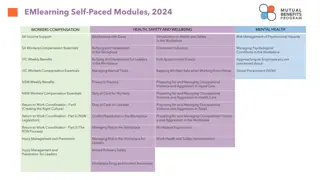


![Workplace Violence Prevention Plan in [District]: Definitions, Elements, and Implementation](/thumb/117038/workplace-violence-prevention-plan-in-district-definitions-elements-and-implementation.jpg)
